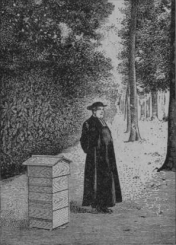
Warré plans
Warré methods
Warré modifications
Warré precursors
Groups / Fora
Google
e-group
Biobees.com
forum
Abbé Warré's book
Beekeeping for All:
Illarion Kullanda, almost a contemporary of Emile Warré, is included among Warré precursors because his hive was a tiered (storified) top-bar hive and was expanded by nadiring, i.e. by adding new elements underneath. However his method departs from the Warré concept because of the use of queen excluders and supering when foraging conditions allowed. His methods involved more intrusion into the colony than Warré's
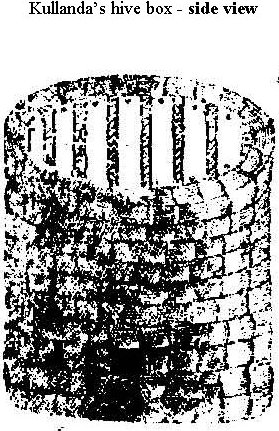
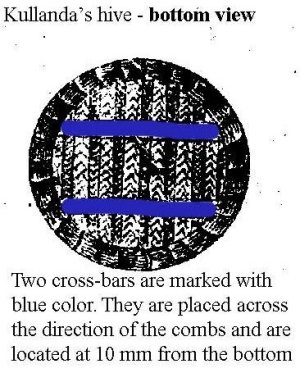
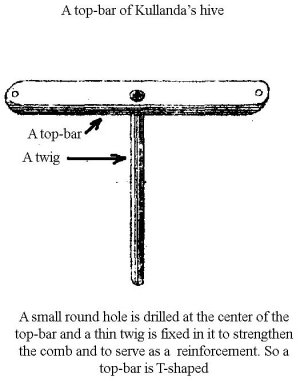
In the last quarter of 19th century Kullanda presented to Rusian peasants his straw top-bar hive. He called it 'The Golden Hive' due to golden color of the straw with which the hive was made, and as a reminder of the ancient Greek 'golden hive" -- a ceramic pot with top-bars. Kullanda very likely had some Greek roots or connections because there are many references to Greek Orthodox monastic beekeeping in his book (1).
The hive comprised cylindrical straw elements (above left) either plaited or formed in a wooden framed press mold (below). The internal dimensions of one cylinder: diameter 267 mm (= 6 vershoks ), height 356 mm (= 8 vershoks). (For the vershok unit of length see http://en.wikipedia.org/wiki/Vershok#Length.) He used also a cylinders of half height (178 mm = 3 vershoks) as supers or nadirs in different cases and seasons. The thickness of the wall was 44.45 mm (= 1 vershok= 1.75 inch).
Two features of Kullanda's hive may be of particular interest to Warré beekeepers. One is the use of two additional bars, 'bottom-bars' or 'cross bars' (top centre illustration), set at right angles to the combs and a bee space (~ 10 mm) from the lowermost edge of the hive element. These provided anchorage sufficient support for the comb that bridging to the top-bars of the element below was eliminated. The other feature is the T-shaped top-bar (above right) which was 24 x 8-9 mm.. The vertical rod strengthens the comb. This might be a relatively simple solution for those Warré beekeepers wishing to make comb safer to remove for inspection without violating retention of nest scent and heat. The top-bars were fixed to the elements with hair pins pushed through the holes at the ends as illustrated.
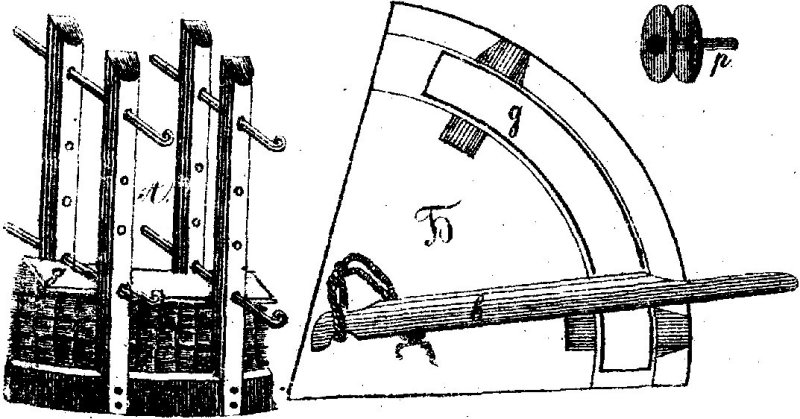
The illustration above shows a part of the press mold used to form a cylindrical straw element of the hive. Kullanda's press mold is 8 pairs of poles standing vertically around a circle of wood. Straw is placed between these pairs of poles to form a whole cylinder, then it is pressed and temporary fixed in pressed status with a board and pins inserted horisontally into the poles. After fixing straw in pressed condition, pressed straw is sewed with a twine or strips of osier. This press mold is similar to common press molds for making flat straw mats. The only difference is its cylindrical form.
Each cylinder had 7 top-bars when it was used for brood, and 6 top-bars when it was used as a super for honey storage. The starters on the top-bars where strips of combs glued with natural glue made from curds, quicklime and water, or with melted wax specially formulated with some additions.
The lid of the hive was a round disk plaited with straw, it had a hole for a feeder, and when no feeder was present the hole was plugged with a wooden plug. For protection from rain and cold Kullanda used a hackle, a cover made with a sheaf of straw.
Regarding the dimensions of the hive: Kullanda insisted that the hive must not be wider than 267 mm, otherwise 'swarms will leave later, and there will be less honey'. He advised using only round (cylindrical) hives, because bees winter better in them rather than in square hives.
His methods of beekeeping was very profound and skilled. He knew and described a large amount of ingenious methods and techniques with his type of hive. He admired Jan Dzierzon (2) as the greatest bee-keeper of all times and peoples. Two further illustrations are taken from Kullanda's book: below left -- Kullanda's hive with posts to stabilise it against winds; below roght -- an invertible swarm skep. It is to be fixed to long pole. After shaking a swarm from the branch to the mouth of the skep it is are turned slowly upright using a rope tied to skep's side. The rest of the swarm then gradually gathers in the skep.
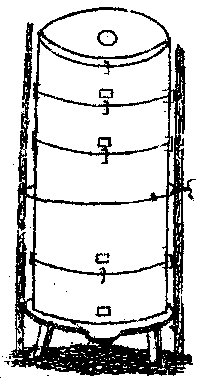
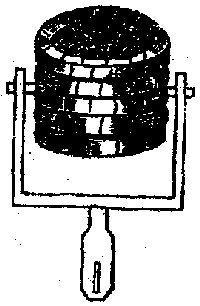
Reference
1) Kullanda, I. S. People's bee - popular manual of right
bee-keeping (1882) A PDF copy of the book is available in the following RAR file IN
RUSSIAN: http://rapidshare.com/files/275857846/Kullanda_People_s_bee.rar
. The book was reprinted in 2009.
![]()
???????? ?.?. "???????? ?????. ????????????? ??????????? ? ???????????
????????????" (?????, 1882)